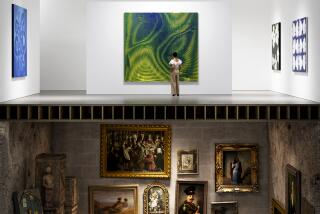New Flair for Two Old Museums : Paris: The famed Jeu de Paume reopens with a clearly contemporary focus. The inaugural exhibition features works of Jean Dubuffet.
PARIS — After a long, famous and infamous history, the rectangular-shaped Galerie Nationale du Jeu de Paume is starting a new life as a museum devoted exclusively to shows by contemporary artists. It is a move that is yet another sign of the cultural revival going on in the French capital.
The popular Paris museum, located on a secluded corner of the Tuileries Gardens, once housed France’s outstanding Impressionist and Post-Impressionist collections. Before the works were moved to the gigantic Musee d’Orsay in 1986, the cozy Jeu de Paume was a favorite tourist stopover where 800,000 visitors came annually to see the world’s largest assembly of paintings by Monet, Manet, Renoir, Cezanne, Gauguin, Van Gogh and others.
The inaugural exhibition at France’s first state-sponsored contemporary art gallery is devoted to the last 10 years of the late French artist Jean Dubuffet. “He is the only French painter to have achieved a first-rate international reputation since World War II,” said Alfred Pacquement, the museum’s director. “He is, along with Jackson Pollock, the greatest painter of the second half of the 20th Century.”
Surprise will await former visitors of the 250-by-40-foot museum that one architect likened to “a stone wagon.” The formerly walled-in reception hall is now an atrium-like open area flooded with natural light from large bay windows, allowing spectacular views of the neighboring Tuileries Gardens, Place de la Concorde and Eiffel Tower.
An inclined white marble corridor leads to the first-floor exhibition rooms while white marble stairways lead to a mezzanine, a sky-lit exhibition room on the second floor and a 100-seat screening room in the basement.
“I wanted very sober exhibition areas, like white pages being given to the artist so he could write on them,” said Antoine Stinco, the museum’s interior architect.
This 19th-Century landmark structure was built by Napoleon III as an indoor court for the game of “Jeu de Paume” (literally “game of the palm”), a forebear of today’s tennis.
A dark chapter in the history of the Jeu de Paume occurred during the Nazi occupation of France. The discretely located museum played an infamous role when it became the storehouse for art seized by the Germans. A total of 21,000 sequestered works passed through the museum during the war before being shipped to Germany. These works included masterpieces from the collections of French Jewish families like the Rothschilds, the David-Weills and the Bernheims.
Moreover, the Nazis used the Jeu de Paume’s back rooms to store whatever they classified as “degenerate art.” Hundreds of banned works by Braque, Chagall, Dali, Matisse, Picasso and others were kept here during the war. More than 500 among these paintings were destroyed and burned by the Nazis in the museum’s garden, while others were bartered against accepted works.
Private, confidential exhibitions were also organized at the Jeu de Paume for Nazi Field Marshall Hermann Goering. Hitler’s deputy was fond of 18th-Century French art and visited the museum to choose paintings for his and Hitler’s personal art collections. In February, 1941, after one of Goering’s visits, 15 crates full of artworks left the museum for Germany. A French Resistance curator working at the museum kept a secret list of all the works passing through, and after the Nazi defeat, most of these works were thereby returned to their rightful owners. (The museum’s war episode was depicted in John Frankenheimer’s 1964 film “The Train,” starring Burt Lancaster and Jeanne Moreau.)
“It’s a fine revenge of history,” Pacquement says, “since the Jeu de Paume will now show contemporary art only and the Nazis would certainly have considered Dubuffet a degenerate artist.”
More to Read
The biggest entertainment stories
Get our big stories about Hollywood, film, television, music, arts, culture and more right in your inbox as soon as they publish.
You may occasionally receive promotional content from the Los Angeles Times.










